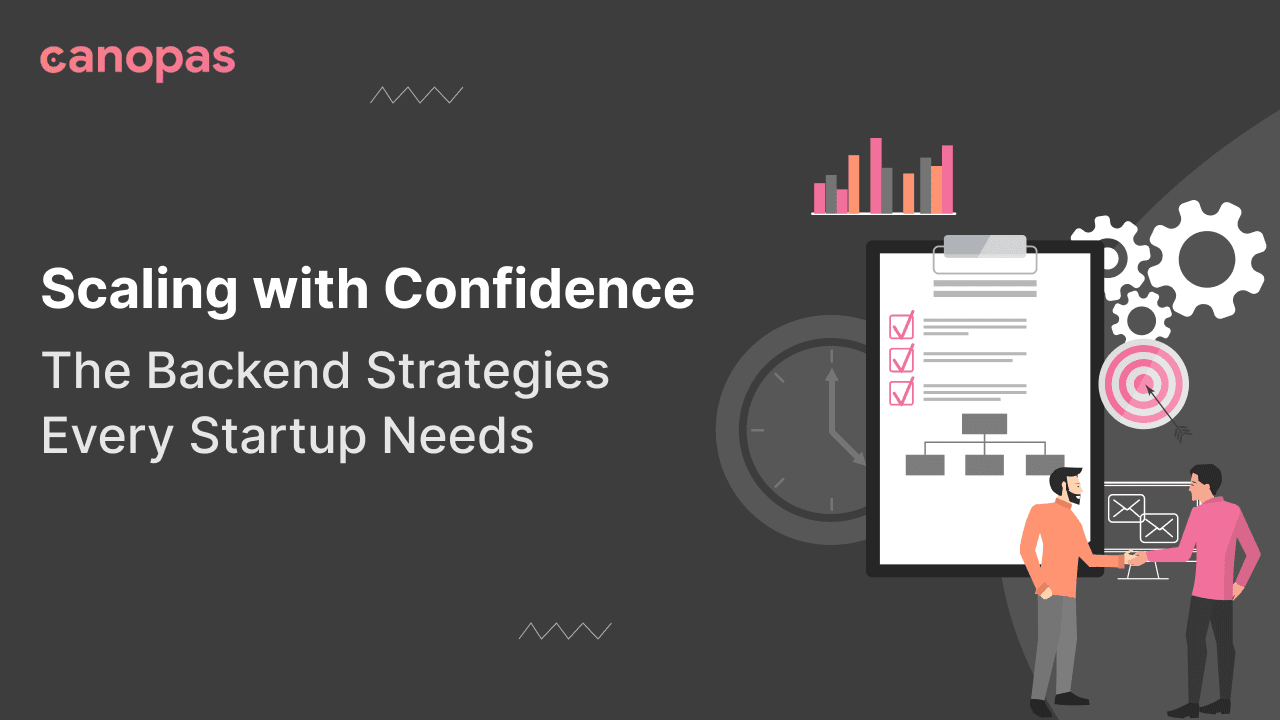
Scaling with Confidence — The Backend Strategies Every Startup Needs
Setting the Foundation — The Power of Backend Development
In the bustling world of startups, everyone talks about the next groundbreaking interface, the latest user experience trend, or the most innovative user engagement strategy.
But behind every seamless user interaction and every rapid feature deployment, there's a silent workhorse propelling startups to their zenith — backend development.
The unsung hero of the digital realm, backend development, plays a pivotal role in a startup's journey, especially when scalability is the goal.
As startups aim to grow their user base, process more data, and integrate newer technologies, the robustness of the backend becomes crucial.
It's not just about creating functionalities; it's about ensuring that as your startup scales, the digital infrastructure can handle the growth without faltering.
In this article, we'll dive deep into why backend development is indispensable for startups aiming for scalability. From ensuring data security to enabling rapid feature rollouts, we'll uncover the backend strategies that can set the foundation for your startup's success.
So, as you dream big and set your sights on expansive horizons, remember: a strong backend can be the difference between smooth sailing and turbulent waters.
The Importance of a Robust Backend for Startups
In the exciting world of startups, where innovation and rapid growth are the cornerstones, the technical foundation on which a product or service stands often determines its longevity and scalability.
That's where the backend development comes into play. Here are some of the important things a startup should consider while designing its backend.
Foundation for Growth
Just like a building requires a solid foundation to withstand external pressures, startups need a robust backend to handle increasing user loads and evolving product features. It ensures the application can accommodate future expansions without significant overhauls.
Data Management and Security
For startups, data is gold. Whether it's user data, transaction details, or business insights, efficient and secure data handling is a mandate. A strong backend ensures data integrity, optimized storage, and protection against breaches.
Feature Deployments and Iterations
Startups thrive on agility. Being able to pivot, iterate, or deploy new features quickly can be a competitive advantage. A well-architected backend facilitates smoother integrations and rapid feature releases.
User Experience (UX) Enhancement
While frontend designs capture users' attention, it's the backend that ensures consistent performance. Faster load times, seamless transactions, and minimal downtimes are all courtesy of a robust backend, leading to an enhanced user experience.
Cost Efficiency
Investing in a solid backend from the outset can save startups from expensive revamps down the line. It reduces the risk of technical debt, where short-term solutions lead to long-term expenses and complexities.
In essence, while the frontend might be the face of your startup's digital product, it's the backend that forms its heart and brain.
Prioritizing backend development is not just a technical decision but a strategic one, directly influencing customer satisfaction, retention, and overall business growth.
What is Scalability?
In the world of startups, the term 'scalability' often floats around.
But what does it truly entail?
Scalability isn't just about handling more users; it's a comprehensive approach that ensures your startup can grow without compromising on the performance or user experience.
Defining Scalability
At its core, scalability means the ability of a system, network, or process to handle a growing amount of work. For startups, this translates to serving an increasing number of users without degrading the quality of service.
Vertical vs. Horizontal Scalability
There are primarily two ways to scale.
- Vertical Scalability (Scaling Up): Involves adding more resources to the existing servers, such as RAM or CPU. While this method is easier and quicker, it has its limitations based on the maximum capacity of individual servers.
- Horizontal Scalability (Scaling Out): Involves adding more machines to the system and distributing the load. This method is more flexible and can cater to massive growth, but it requires a well-architected backend system to ensure smooth distribution of workload.
Why Startups Need to Think About Scalability.
Startups, more than established enterprises, need to be agile. They have to be ready to pivot based on market demand, and with every pivot, the backend needs might change. A scalable backend ensures that any new feature integration, user surge, or business model shift can be handled seamlessly.
The Real-World Implications of Scalability
It's not just about system capacity. Scalability impacts:
- User Experience: Slow load times or frequent crashes can push users away. A scalable backend ensures consistent performance.
- Cost Efficiency: Predicting and managing costs becomes more straightforward when you have a scalable solution. Rather than overprovisioning, you can allocate resources more efficiently.
- Future-Proofing: Today's startup can be tomorrow's tech giant. Building with scalability in mind ensures you won't have to redo everything from scratch when growth happens.
The Role of Backend in Scalability
The backend is like the foundation of a building. If it's not robust, the entire structure (your app or platform) can crumble under pressure.
A flexible, robust, and scalable backend can adapt to changing user demands, traffic surges, and new feature integrations without a hitch.
In conclusion, understanding scalability goes beyond just prepping for user growth. It's about foreseeing potential challenges and ensuring that your startup remains agile, responsive, and resilient in the face of change.
Your backend strategy, therefore, should not be an afterthought, but a driving force in your startup's journey.
Key Backend Strategies for Scalability
Scaling a startup isn't merely about getting more users or traffic; it's about handling that increase effectively without causing system breakdowns or degraded user experiences.
The backend, as the foundation of your software application, holds the key. Here’s an in-depth look at some essential backend strategies that startups should incorporate for seamless scalability.
Microservices Architecture
- What it is: Unlike monolithic structures where every process is intertwined, microservices break down applications into small, manageable pieces that operate independently.
- Why it matters: This architecture allows individual components to be scaled as needed. If one service experiences high demand, it can be scaled up without affecting others. This results in cost savings and performance enhancements.
Database Sharding
- What it is: Instead of having one monolithic database, sharding breaks it down into smaller, faster, more easily managed parts, or 'shards'.
- Why it matters: As user bases grow, database requests can become a bottleneck. Sharding alleviates this by distributing the load, improving response times, and reducing potential points of failure.
Implementing Caching
- What it is: Caching stores frequently used data in 'ready-to-serve' states, so the system doesn't have to re-fetch or re-compute it every time.
- Why it matters: It significantly reduces the workload on databases, ensuring faster response times and a smoother user experience, especially during traffic surges.
Content Delivery Network (CDN) Integration
- What it is: CDNs are distributed networks that store copies of your content in various locations, ensuring users access data from the nearest point.
- Why it matters: For startups aiming for a global audience, CDNs ensure that all users, regardless of their location, get optimal speeds and experience.
Backend Monitoring and Analytics
- What it is: Tools and platforms that provide real-time insights into the backend's performance, spotting potential issues before they escalate.
- Why it matters: Proactive monitoring helps in anticipating problems, understanding traffic patterns, and making informed decisions about where and when to scale.
Load Balancing
- What it is: A technique to distribute incoming traffic across multiple servers to ensure no single server is overwhelmed.
- Why it matters: Load balancers optimize resource use, maximize throughput, reduce latency, and ensure high availability and reliability.
Serverless Architectures
- What it is: Instead of running applications on specific servers, serverless architectures run code in response to events. You only use resources when a function is invoked.
- Why it matters: For startups, this means lower operational costs, as you only pay for what you use. It also ensures automatic scaling without manual intervention.
Implementing these backend strategies not only equips startups for present challenges but also future-proofs them for unprecedented growth.
While every startup's journey is unique, a robust and scalable backend is a common denominator for success in the ever-evolving digital realm.
Real-world Examples — Startups That Got It Right
Behind many of today's tech unicorns and successful startups lies a backend strategy that facilitated their rapid growth.
They're not just stories of entrepreneurial spirit and market strategy; they’re also tales of technological robustness. Let’s delve into a few of them.
Dropbox
- The Challenge: Being a cloud storage solution, Dropbox faced the massive task of storing, syncing, and retrieving user data in real-time across various devices.
- Backend Strategy: Dropbox used a combination of Python and Go to optimize its backend processes. Additionally, they shifted from traditional file storage methods to block storage, ensuring quick syncing and retrieval of data. Their scalable backend allowed them to handle the influx of users without significant architectural changes.
Airbnb
- The Challenge: With a growing number of listings and users worldwide, Airbnb had to ensure their platform was responsive, reliable, and real-time.
- Backend Strategy: Airbnb moved from a monolithic architecture to a service-oriented architecture. This modularity allowed them to scale different parts of their app independently. Coupled with a robust database strategy using tools like Apache Cassandra, they ensured users got real-time availability and booking information.
Slack
- The Challenge: As a real-time communication platform, Slack had to handle millions of messages, files, and active users every day.
- Backend Strategy: Slack uses a multi-tiered backend approach, combining PHP, Java, and C++. They also utilize WebSockets for real-time communication. To maintain fast search capabilities, they optimized their database structures and queries. This robust backend allows Slack to support thousands of teams without lag.
These startups realized early on that a solid backend strategy wasn't just about supporting their current user base; it was about preparing for exponential growth.
Their foresight and technological choices laid the groundwork for their immense success in today's market.
Mistakes to Avoid — Lessons from the Trenches
While there are many success stories of startups nailing their backend strategies, the path to scalability is littered with pitfalls.
Here are some common mistakes startups have made, offering lessons for others to heed.
Neglecting Performance Testing
- The Mistake: Startups often prioritize feature development over stress and performance testing, assuming they'll tackle scalability once they gain more users.
- The Lesson: Always stress-test your system early and often. It’s easier to fix performance issues in the early stages than during a crisis when user experience is already affected.
Relying Too Heavily on Legacy Systems
- The Mistake: In an attempt to save costs, some startups may use outdated systems or platforms, believing they can modernize later.
- The Lesson: Legacy systems can hinder growth. Investing in modern, scalable technologies from the outset might seem costly, but it pays off in the long run.
Ignoring Database Scalability
- The Mistake: Overlooking the importance of a scalable database, leading to inefficiencies as user load increases.
- The Lesson: Your database is the heart of your application. Opt for databases known for scalability, and consider strategies like sharding and replication.
Lacking a Proper Error-Handling System
- The Mistake: Not having an adequate system to detect, log, and notify about errors in real-time.
- The Lesson: As you scale, problems will arise. An effective error-handling system ensures you catch them early before they escalate.
Overlooking Security Concerns
- The Mistake: Sacrificing security in the race to add features or scale quickly.
- The Lesson: As your user base grows, so does the attention from malicious entities. Prioritize security to protect user data and maintain trust.
Not Planning for High Availability
- The Mistake: Failing to consider backup systems or redundancies, leading to downtimes during traffic spikes or failures.
- The Lesson: Ensure that your backend infrastructure is designed for high availability. This includes having failovers, backups, and disaster recovery plans in place.
Remember, every mistake or oversight in the backend can amplify as you grow. It's crucial to be proactive rather than reactive.
While it's challenging to predict every hurdle, learning from those who've been in the trenches can provide invaluable insights for your startup's journey.
Future-Proofing Your Startup's Backend
Anticipating the future is never a straightforward task, especially in the fast-paced world of technology.
Yet, when it comes to backend development, a forward-looking approach is indispensable for startups aiming to stand the test of time.
Here's how you can future-proof your startup's backend.
Adopt a Microservices Architecture
- Why: A monolithic backend can quickly become unwieldy as your application grows. Microservices split your backend into smaller, independent modules, making it easier to update, scale, and maintain different parts of your application independently.
- How: Begin by identifying distinct functionalities within your application and considering how they can operate as independent services.
Prioritize API-First Development
- Why: With the proliferation of devices and platforms, your backend should be ready to serve a variety of frontend applications - from mobile apps to web interfaces and IoT devices.
- How: Design robust and comprehensive APIs from the outset, ensuring they are flexible and well-documented for future integrations.
Invest in Continuous Integration and Continuous Deployment (CI/CD)
- Why: The tech landscape evolves rapidly. CI/CD practices ensure that you can roll out updates, patches, and new features seamlessly without causing disruptions.
- How: Utilize CI/CD platforms and automate your deployment pipeline to push changes efficiently.
Stay Updated with Emerging Technologies
- Why: The backend tools and frameworks that are popular today might become obsolete tomorrow.
- How: Dedicate time for regular R&D within your team. Encourage learning and experimentation with new backend technologies and practices.
Plan for Scalable Data Management
- Why: As your user base expands, so will the volume of data you handle. Efficient data management is crucial for performance and insights.
- How: Consider scalable database solutions and employ techniques such as data sharding, caching, and database optimization.
Ensure Backward Compatibility
- Why: While it's essential to keep moving forward, you shouldn't leave your existing users behind. New updates should not break the experience for users on older versions.
- How: Test new changes with older versions of your frontend applications. Provide clear migration paths for users when major backend shifts occur.
Foster a Culture of Continuous Learning
- Why: Beyond tools and technologies, your team's mindset is a critical factor in future-proofing. A team that's eager to learn and adapt will always find ways to innovate and stay relevant.
- How: Promote regular training sessions, workshops, and encourage team members to attend industry conferences.
In essence, future-proofing is not about predicting every change on the horizon but equipping your startup's backend to adapt and evolve.
By investing in flexibility, scalability, and a culture of continual improvement, you'll ensure that your backend remains robust and resilient, no matter what the future holds.
Secure Tomorrow's Success Today with Canopas
The landscape of startups and technology is one of constant flux, making it vital for emerging companies to not only be reactive but proactive.
As we've journeyed through the nuances of backend scalability and future-proofing, it becomes clear that the backend forms the very spinal cord of any tech-driven startup's aspirations.
If you're an entrepreneur or a decision-maker in a startup, remember this: While your product's frontend might capture the user's attention, it's the backend that will earn their trust and loyalty.
Ensuring that your backend infrastructure is robust, scalable, and forward-looking isn't just a technical decision—it's a strategic one.
At Canopas, we're passionate about helping startups translate their visions into technological realities.
Whether you're just starting out or looking to revamp your existing backend architecture, our team of experts is here to guide, support, and co-create.
Reach out to us today and let's ensure that your startup is not just ready for today, but also poised for the successes of tomorrow. Contact us now to embark on a journey of seamless scalability and innovation.








